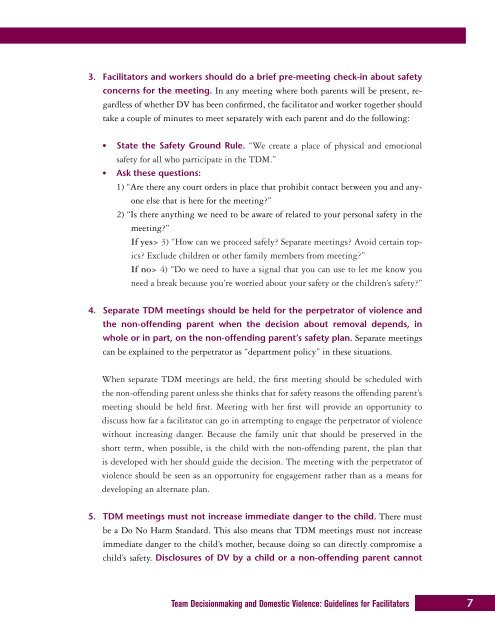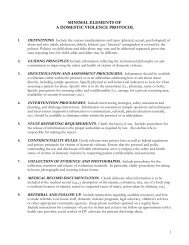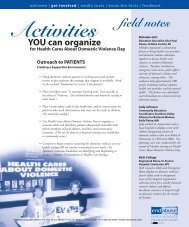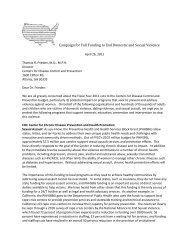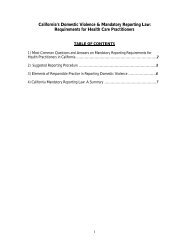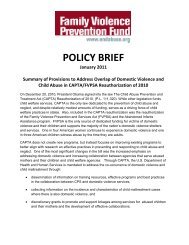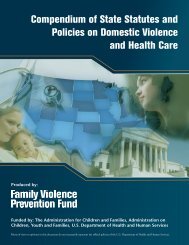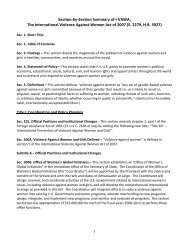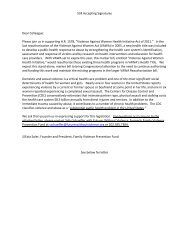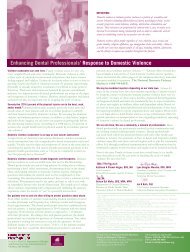Team Decisionmaking and Domestic Violence: Guidelines for ...
Team Decisionmaking and Domestic Violence: Guidelines for ...
Team Decisionmaking and Domestic Violence: Guidelines for ...
You also want an ePaper? Increase the reach of your titles
YUMPU automatically turns print PDFs into web optimized ePapers that Google loves.
3. Facilitators <strong>and</strong> workers should do a brief pre-meeting check-in about safety<br />
concerns <strong>for</strong> the meeting. In any meeting where both parents will be present, regardless<br />
of whether DV has been confirmed, the facilitator <strong>and</strong> worker together should<br />
take a couple of minutes to meet separately with each parent <strong>and</strong> do the following:<br />
• State the Safety Ground Rule. “We create a place of physical <strong>and</strong> emotional<br />
safety <strong>for</strong> all who participate in the TDM.”<br />
• Ask these questions:<br />
1) “Are there any court orders in place that prohibit contact between you <strong>and</strong> anyone<br />
else that is here <strong>for</strong> the meeting?”<br />
2) “Is there anything we need to be aware of related to your personal safety in the<br />
meeting?”<br />
If yes> 3) “How can we proceed safely? Separate meetings? Avoid certain topics?<br />
Exclude children or other family members from meeting?”<br />
If no> 4) “Do we need to have a signal that you can use to let me know you<br />
need a break because you’re worried about your safety or the children’s safety?”<br />
4. Separate TDM meetings should be held <strong>for</strong> the perpetrator of violence <strong>and</strong><br />
the non-offending parent when the decision about removal depends, in<br />
whole or in part, on the non-offending parent’s safety plan. Separate meetings<br />
can be explained to the perpetrator as “department policy” in these situations.<br />
When separate TDM meetings are held, the first meeting should be scheduled with<br />
the non-offending parent unless she thinks that <strong>for</strong> safety reasons the offending parent’s<br />
meeting should be held first. Meeting with her first will provide an opportunity to<br />
discuss how far a facilitator can go in attempting to engage the perpetrator of violence<br />
without increasing danger. Because the family unit that should be preserved in the<br />
short term, when possible, is the child with the non-offending parent, the plan that<br />
is developed with her should guide the decision. The meeting with the perpetrator of<br />
violence should be seen as an opportunity <strong>for</strong> engagement rather than as a means <strong>for</strong><br />
developing an alternate plan.<br />
5. TDM meetings must not increase immediate danger to the child. There must<br />
be a Do No Harm St<strong>and</strong>ard. This also means that TDM meetings must not increase<br />
immediate danger to the child’s mother, because doing so can directly compromise a<br />
child’s safety. Disclosures of DV by a child or a non-offending parent cannot<br />
<strong>Team</strong> <strong>Decisionmaking</strong> <strong>and</strong> <strong>Domestic</strong> <strong>Violence</strong>: <strong>Guidelines</strong> <strong>for</strong> Facilitators 7


